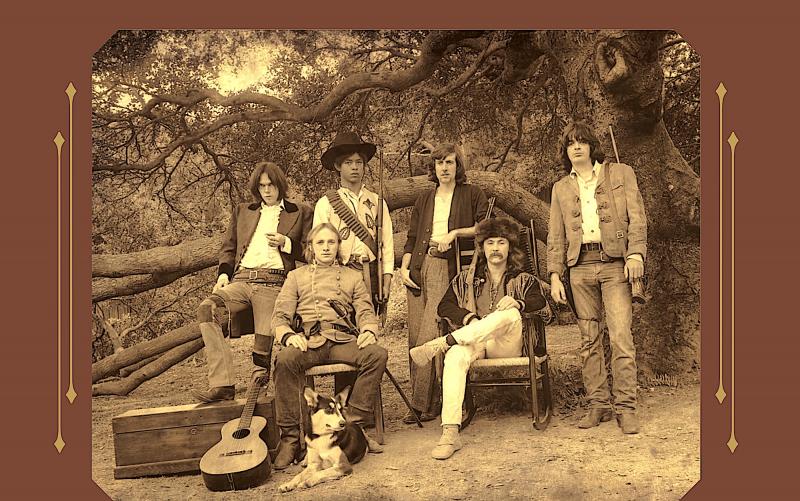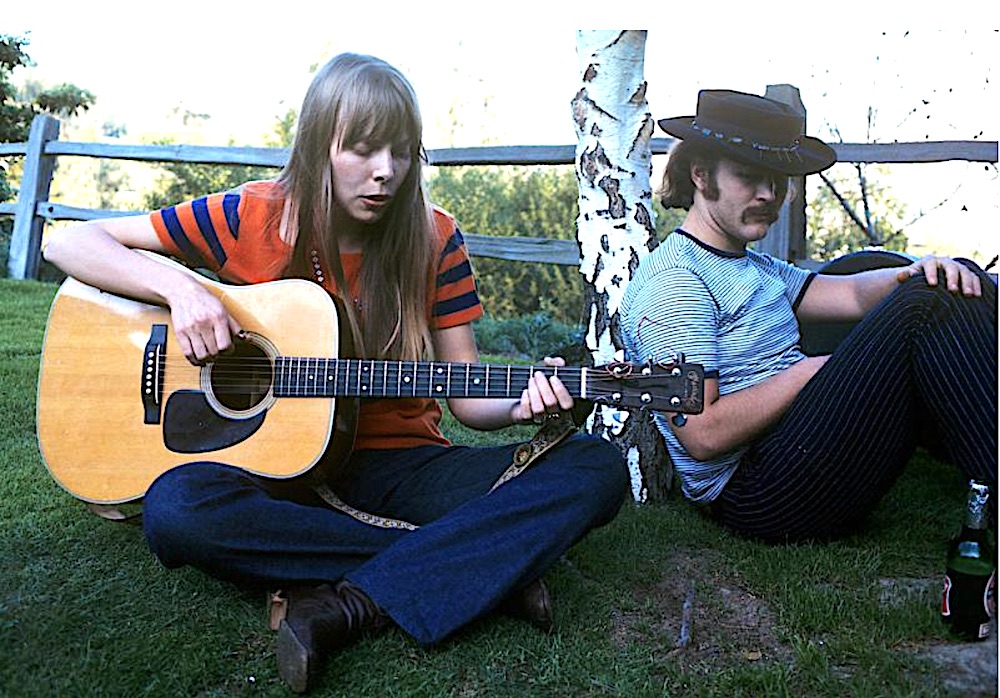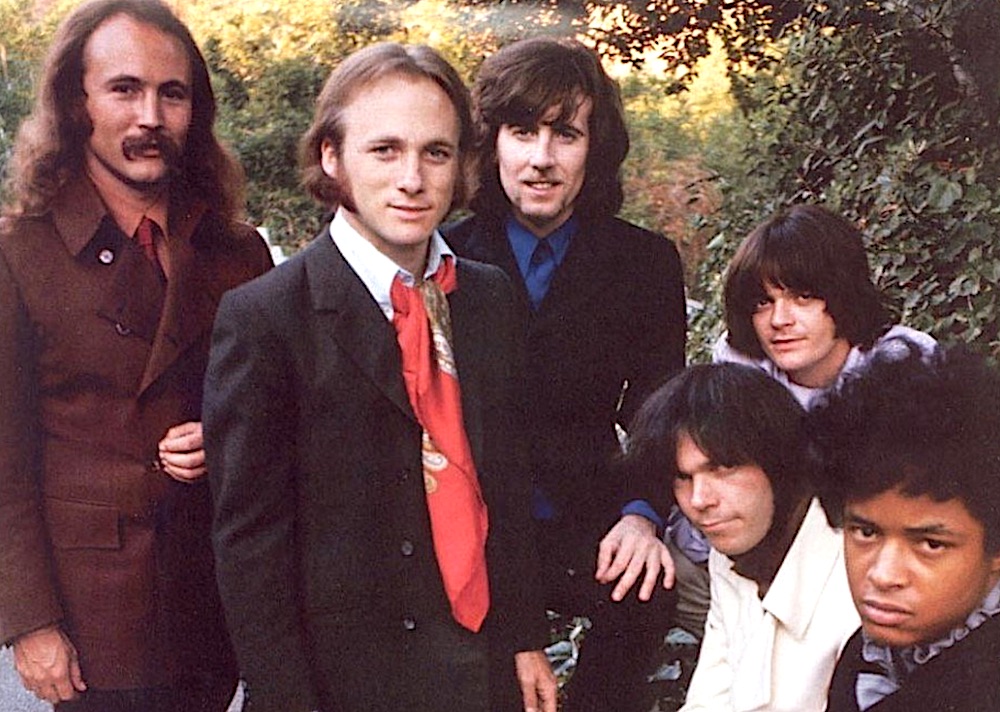Crosby, Stills, Nash and Young: Déjà Vu 50th Anniversary Deluxe Edition | reviews, news & interviews
Crosby, Stills, Nash and Young: Déjà Vu 50th Anniversary Deluxe Edition
Crosby, Stills, Nash and Young: Déjà Vu 50th Anniversary Deluxe Edition
California combo's fabled second album gets a monster 4-disc reissue

With over eight million copies sold in its 50-year lifespan, Déjà Vu was, as Cameron Crowe writes in the booklet accompanying this compendious four-CD edition, “one of the most famous second albums in rock history”.
CS&N had now gained their Y in the brooding form of Neil Young, and the indivisible tightness of the original trio – so exactly mirrored in their radiant harmony singing – now had to find a way to accommodate the brilliant but obstinately solitary Canadian. While the original three added their harmonies to Young’s songs, Young was never part of the CSN chorus. While they were recording Déjà Vu at Wally Heider’s LA studio by day, Young would slip away to Sunset Sound studios at night to work on his solo album, After the Gold Rush.
As Graham Nash told Young’s biographer Jimmy McDonough: “Neil was very Neil during Déjà Vu. He never played us all his songs… and he would take his CSNY tracks down to the studio, do overdubs and mix ‘em himself. Once again, it’s part of Neil’s insatiable quest for control.” Young disingenuously commented that CSNY was “something that I did every once in a while.”
One can only speculate about the outcome if, instead of Young, CSN had managed to recruit Steve Winwood or John Sebastian, both of whom were approached (one little treat included here is CSN’s beautifully touching version of Sebastian’s wanderer's-return ballad “How Have You Been”). But Young proved to be the grit in the oyster, and whatever upheavals went into it, Déjà Vu stands as a monument to the hippy dream while also signalling the end of it. Recording sessions began in Los Angeles on 15 July 1969, and ended at Wally Heider’s in San Francisco on 28 December, on the brink of the new decade. In between, CSNY had appeared at the Woodstock Festival, the symbolic high tide of the counterculture, but also at the accursed Altamont Festival on 6 December ‘69, now frequently (if glibly) cited as the day the Sixties died. Only three months after Déjà Vu’s release, CSNY recorded Young’s song "Ohio", his searing musical news bulletin inspired by the shooting of anti-Vietnam war protestors at Kent State university.
Recording sessions began in Los Angeles on 15 July 1969, and ended at Wally Heider’s in San Francisco on 28 December, on the brink of the new decade. In between, CSNY had appeared at the Woodstock Festival, the symbolic high tide of the counterculture, but also at the accursed Altamont Festival on 6 December ‘69, now frequently (if glibly) cited as the day the Sixties died. Only three months after Déjà Vu’s release, CSNY recorded Young’s song "Ohio", his searing musical news bulletin inspired by the shooting of anti-Vietnam war protestors at Kent State university.
Turbulent times, mirrored in the frazzled mental states of the musicians. The recording of Crosby Stills & Nash had found the participants basking in the glow of musical and personal harmony, but the Déjà Vu sessions were quite the opposite. Nash had split up from his paramour Joni Mitchell (another of the extra gems here is a ragged demo recording of “Our House” by Nash and Joni, ending in peals of Joni laughter), Stills and Judy Collins had parted company, and worst of all, Crosby was in a state of trauma after the death of his girlfriend Christine Hinton in a car accident. “He was never the same,” Nash remarked (pictured above, Joni Mitchell and David Crosby).
The resulting album is a milestone, though the way that it feels more like four singer-songwriters loosely collaborating than a cohesive band has sawn away at the collective ethic of the debut album. No question, it has its episodes of brilliance. The opening track, “Carry On”, was one of Stephen Stills’s finest moments as writer and arranger, as he fused together “Carry On” with a reworking of “Questions”, originally written for his previous band, Buffalo Springfield. This worked outrageously well, the crowning inspirational touch being the insertion of a spectacular vocal chorale – the “love is coming, love is coming to us all” section – as the hinge between the two halves. This is also a Young-free zone, and a showcase for the multi-instrumental Stills (there’s an alternate version on Disc 4 featuring much more of Stills’s funky wah-wah guitar than on the final version). Kudos, incidentally, to drummer Dallas Taylor and precocious teenage bassist Greg Reeves, only 15 when he played on the Déjà Vu sessions and already a veteran of recordings with The Supremes and The Temptations at Motown.
Nash’s simple ditties, “Our House” and “Teach Your Children”, have outlasted their superficial tweeness and seem like messages in a bottle from a lost era, while the hanging chords, shifting time signatures and strange harmonies of Crosby’s title track evoke a state of mysterious suspended animation. Young’s contributions never felt like his best work (no doubt he was saving them for his solo recordings), though "Helpless" exerts a kind of exhausted charm. As for his grandiose “Country Girl”, perhaps intended to be a mini-symphony in the vein of “Expecting To Fly”, it adds up to less than its three separate parts. At least Young helped to complete “Everybody I Love You” by putting an ending on Stills’s “Know You Got To Run”, which, as an earlier take reveals, was just an infinite loop of headbanging chords. Young's major contribution was, arguably, his blazing lead guitar work on the combo's rampaging version of Joni Mitchell's "Woodstock".
Young’s contributions never felt like his best work (no doubt he was saving them for his solo recordings), though "Helpless" exerts a kind of exhausted charm. As for his grandiose “Country Girl”, perhaps intended to be a mini-symphony in the vein of “Expecting To Fly”, it adds up to less than its three separate parts. At least Young helped to complete “Everybody I Love You” by putting an ending on Stills’s “Know You Got To Run”, which, as an earlier take reveals, was just an infinite loop of headbanging chords. Young's major contribution was, arguably, his blazing lead guitar work on the combo's rampaging version of Joni Mitchell's "Woodstock".
The nitty-gritty of this release lies in the myriad of outtakes and demos, where the musicians worked through the Déjà Vu material but a lot more besides. For instance, Stills delivers a lovely ripple-picking solo version of “So Begins the Task”, later adapted for the Manassas double album, and a much more plausible acoustic version of “Know You Got to Run”. “She Can’t Handle It” would end up as “Church” on Stills’s first solo album. He also leads the group through funk-rock workouts on “I’ll Be There”, “Same Old Song” and “Everyday We Live”, which aren’t great songs but do sound very like the way CSNY played on the 4 Way Street live album.
There are a couple of Nash solo items, “Question Why” (simple folk-pop) and “Sleep Song” (horribly syrupy), but it’s Crosby who springs the biggest selection of surprises. There are two versions of “Laughing”, one solo and one with (presumably) Stills and Nash, each excellent in different ways and entirely different from the version on Crosby's solo disc If I Could Only Remember My Name. A solo take of “Triad”, which Jefferson Airplane recorded after The Byrds didn’t want it, is a mesmerising mix of Crosby’s coolly mellifluous voice and quizzical jazzy chords and harmonics. For good measure there’s a version of his oceanic odyssey “The Lee Shore”, with its original 1969 vocals.
It’s an absorbing deep-dive into the group’s teeming creativity as the Sixties wound to a close, with plenty of clues about where they’d go next. Typically, though, extra demos or outtakes from the secretive Neil Young are conspicuous by their absence, other than a version of “Birds” (which would appear on After the Gold Rush) featuring just Young and Nash. Amusingly, Nash has to point out to Neil that his guitar is out of tune.
- Déjà Vu: 50th Anniversary Deluxe Edition, comprising 4 CDs and 1 LP, is released by Rhino on 14 May
- More New Music reviews on theartsdesk
rating
Share this article
The future of Arts Journalism
You can stop theartsdesk.com closing!
We urgently need financing to survive. Our fundraising drive has thus far raised £49,000 but we need to reach £100,000 or we will be forced to close. Please contribute here: https://gofund.me/c3f6033d
And if you can forward this information to anyone who might assist, we’d be grateful.

Subscribe to theartsdesk.com
Thank you for continuing to read our work on theartsdesk.com. For unlimited access to every article in its entirety, including our archive of more than 15,000 pieces, we're asking for £5 per month or £40 per year. We feel it's a very good deal, and hope you do too.
To take a subscription now simply click here.
And if you're looking for that extra gift for a friend or family member, why not treat them to a theartsdesk.com gift subscription?
more New music
 Music Reissues Weekly: Joe Meek - A Curious Mind
How the maverick Sixties producer’s preoccupations influenced his creations
Music Reissues Weekly: Joe Meek - A Curious Mind
How the maverick Sixties producer’s preoccupations influenced his creations
 Pop Will Eat Itself, O2 Institute, Birmingham review - Poppies are back on patrol
PWEI hit home turf and blow the place up
Pop Will Eat Itself, O2 Institute, Birmingham review - Poppies are back on patrol
PWEI hit home turf and blow the place up
 'Fevereaten' sees gothic punk-metallers Witch Fever revel in atmospheric paganist raging
Second album from heavy-riffing quartet expands sonically on their debut
'Fevereaten' sees gothic punk-metallers Witch Fever revel in atmospheric paganist raging
Second album from heavy-riffing quartet expands sonically on their debut
 theartsdesk Q&A: Soft Cell
Upon the untimely passing of Dave Ball we revisit our September 2018 Soft Cell interview
theartsdesk Q&A: Soft Cell
Upon the untimely passing of Dave Ball we revisit our September 2018 Soft Cell interview
 Demi Lovato's ninth album, 'It's Not That Deep', goes for a frolic on the dancefloor
US pop icon's latest is full of unpretentious pop-club bangers
Demi Lovato's ninth album, 'It's Not That Deep', goes for a frolic on the dancefloor
US pop icon's latest is full of unpretentious pop-club bangers
 Yazmin Lacey confirms her place in a vital soul movement with 'Teal Dreams'
Intimacy and rich poetry on UK soul star's second LP
Yazmin Lacey confirms her place in a vital soul movement with 'Teal Dreams'
Intimacy and rich poetry on UK soul star's second LP
 Solar Eyes, Hare & Hounds, Birmingham review - local lads lay down some new tunes for a home crowd
Psychedelic indie dance music marinated in swirling dry ice
Solar Eyes, Hare & Hounds, Birmingham review - local lads lay down some new tunes for a home crowd
Psychedelic indie dance music marinated in swirling dry ice
 The Lemonheads' 'Love Chant' is a fine return to form
Evan Dando finally gets back in the saddle with an album of new tunes
The Lemonheads' 'Love Chant' is a fine return to form
Evan Dando finally gets back in the saddle with an album of new tunes
 Music Reissues Weekly: Evie Sands - I Can’t Let Go
Diligent, treasure-packed tribute to one of Sixties’ America’s great vocal stylists
Music Reissues Weekly: Evie Sands - I Can’t Let Go
Diligent, treasure-packed tribute to one of Sixties’ America’s great vocal stylists
 'Deadbeat': Tame Impala's downbeat rave-inspired latest
Fifth album from Australian project grooves but falls flat
'Deadbeat': Tame Impala's downbeat rave-inspired latest
Fifth album from Australian project grooves but falls flat
 Heartbreak and soaring beauty on Chrissie Hynde & Pals' Duets Special
The great Pretender at her most romantic and on the form of her life
Heartbreak and soaring beauty on Chrissie Hynde & Pals' Duets Special
The great Pretender at her most romantic and on the form of her life
 The Last Dinner Party's 'From the Pyre' is as enjoyable as it is over-the-top
Musically sophisticated five-piece ramp up the excesses but remain contagiously pop
The Last Dinner Party's 'From the Pyre' is as enjoyable as it is over-the-top
Musically sophisticated five-piece ramp up the excesses but remain contagiously pop

Add comment